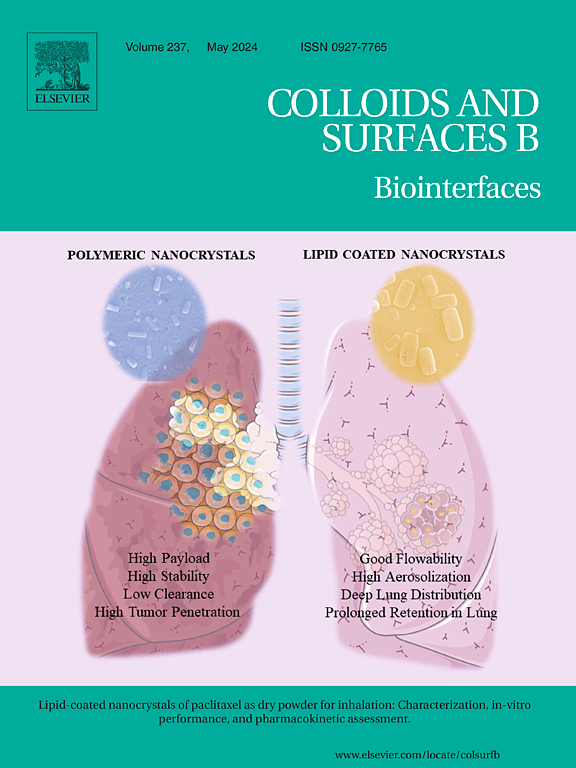Innovative CuO-melanin hybrid nanoparticles and polytetrafluoroethylene for enhanced antifouling coatings
IF 5.4
2区 医学
Q1 BIOPHYSICS
引用次数: 0
Abstract
Based on current research, a highly effective, completely biocompatible, and eco-friendly antifouling method was developed. Sepia pharaonis was used to synthesize melanin nanoparticles from its ink. To improve the anti-biofouling characteristics, CuO nanoparticles were synthesized from Padina sp., and a CuO-melanin hybrid nanoparticle complex was created under reflux. The XRD spectrum of the hybrid nanoparticles revealed several prominent peaks, indicating the crystalline structure of the nanoparticles. An EDS analysis identified copper, carbon, and oxygen in the hybrid nanoparticles. According to FE-SEM analysis, CuO-melanin hybrid nanoparticles displayed spherical morphology, with sizes ranging from 15 nm to 55 nm. DLS analysis showed that the hydrodynamic diameter of CuO-melanin hybrid nanoparticles was 187.5 nm. The biological test showed that CuO-melanin nanoparticles had the highst effect on marine bacteria (Phaeobacter sp. (6.25 μg/mL), Alteromonas sp. (12.5 μg/mL)), and algae (Isochrysis galbana Parke) (99 %) after 48 h. The CuO-melanin (3 wt%) exhibited the lowest pseudo-barnacle adhesion strength at 0.021 MPa and the lowest surface free energy, measuring 14.22 mN/m. The field immersion study in a marine environment showed that among the panels tested, the one containing 3 wt% CuO-melanin hybrid nanoparticles with polytetrafluoroethylene yielded the most favorable and efficient outcome, since it led to the lowest measured weight of biofouling at 26.44 g. The findings of this study show that CuO-melanin hybrid nanoparticles combined with polytetrafluoroethylene exhibit highly promising characteristics, make them appealing for antifouling applications.
用于增强防污涂层的创新型氧化铜-黑色素杂化纳米粒子和聚四氟乙烯。
在目前研究的基础上,开发出了一种高效、完全生物兼容且环保的防污方法。研究人员利用法氏囊虫从其墨汁中合成了黑色素纳米粒子。为了提高防生物污损的特性,利用 Padina sp.合成了 CuO 纳米粒子,并在回流条件下生成了 CuO-黑色素混合纳米粒子复合物。杂化纳米粒子的 XRD 光谱显示出几个突出的峰值,表明纳米粒子具有晶体结构。EDS 分析确定了杂化纳米粒子中的铜、碳和氧。根据 FE-SEM 分析,CuO-黑色素杂化纳米粒子呈球形,大小在 15 纳米到 55 纳米之间。DLS 分析表明,CuO-黑色素杂化纳米粒子的流体力学直径为 187.5 nm。生物测试表明,48 小时后,CuO-黑色素纳米粒子对海洋细菌(Phaeobacter sp.(6.25 μg/mL)、Alteromonas sp.(12.5 μg/mL))和藻类(Isochrysis galbana Parke)(99 %)的抑制率最高。CuO-黑色素(3 wt%)表现出最低的假水泡粘附强度(0.021 兆帕)和最低的表面自由能(14.22 mN/m)。在海洋环境中进行的现场浸泡研究表明,在所测试的面板中,含有 3 wt% CuO-美兰宁混合纳米粒子和聚四氟乙烯的面板产生的结果最有利、最有效,因为它导致生物污垢的测量重量最低,仅为 26.44 克。这项研究的结果表明,氧化铜-黑色素杂化纳米粒子与聚四氟乙烯的结合表现出非常有前景的特性,使其在防污应用中具有吸引力。
本文章由计算机程序翻译,如有差异,请以英文原文为准。
求助全文
约1分钟内获得全文
求助全文
来源期刊

Colloids and Surfaces B: Biointerfaces
生物-材料科学:生物材料
CiteScore
11.10
自引率
3.40%
发文量
730
审稿时长
42 days
期刊介绍:
Colloids and Surfaces B: Biointerfaces is an international journal devoted to fundamental and applied research on colloid and interfacial phenomena in relation to systems of biological origin, having particular relevance to the medical, pharmaceutical, biotechnological, food and cosmetic fields.
Submissions that: (1) deal solely with biological phenomena and do not describe the physico-chemical or colloid-chemical background and/or mechanism of the phenomena, and (2) deal solely with colloid/interfacial phenomena and do not have appropriate biological content or relevance, are outside the scope of the journal and will not be considered for publication.
The journal publishes regular research papers, reviews, short communications and invited perspective articles, called BioInterface Perspectives. The BioInterface Perspective provide researchers the opportunity to review their own work, as well as provide insight into the work of others that inspired and influenced the author. Regular articles should have a maximum total length of 6,000 words. In addition, a (combined) maximum of 8 normal-sized figures and/or tables is allowed (so for instance 3 tables and 5 figures). For multiple-panel figures each set of two panels equates to one figure. Short communications should not exceed half of the above. It is required to give on the article cover page a short statistical summary of the article listing the total number of words and tables/figures.
 求助内容:
求助内容: 应助结果提醒方式:
应助结果提醒方式:


